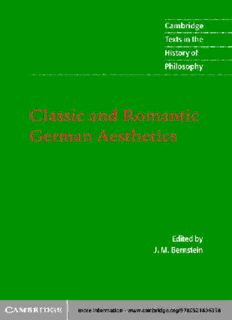
Classic and Romantic German Aesthetics PDF
Preview Classic and Romantic German Aesthetics
This page intentionally left blank CAMBRIDGE TEXTS IN THE HISTORY OF PHILOSOPHY Classic and Romantic German Aesthetics CAMBRIDGE TEXTS IN THE HISTORY OF PHILOSOPHY Serieseditors KARL AMERIKS ProfessorofPhilosophyattheUniversityofNotreDame DESMOND M. CLARKE ProfessorofPhilosophyatUniversityCollegeCork ThemainobjectiveofCambridgeTextsintheHistoryofPhilosophyistoexpandtherange, varietyandqualityoftextsinthehistoryofphilosophywhichareavailableinEnglish. Theseriesincludestextsbyfamiliarnames(suchasDescartesandKant)andalsobyless well-knownauthors.Whereverpossible,textsarepublishedincompleteandunabridged form,andtranslationsarespeciallycommissionedfortheseries.Eachvolumecontainsa criticalintroductiontogetherwithaguidetofurtherreadingandanynecessaryglossaries andtextualapparatus.Thevolumesaredesignedforstudentuseatundergraduateand postgraduatelevelandwillbeofinterestnotonlytostudentsofphilosophy,butalsotoa wideraudienceofreadersinthehistoryofscience,thehistoryoftheologyandthehistory ofideas. Foralistoftitlespublishedintheseries,pleaseseeendofbook. Classic and Romantic German Aesthetics J. M. BERNSTEIN NewSchoolUniversity,NewYork Cambridge, New York, Melbourne, Madrid, Cape Town, Singapore, São Paulo Cambridge University Press The Edinburgh Building, Cambridge , United Kingdom Published in the United States of America by Cambridge University Press, New York www.cambridge.org Information on this title: www.cambridge.org/9780521806398 © Cambridge University Press 2003 This book is in copyright. Subject to statutory exception and to the provision of relevant collective licensing agreements, no reproduction of any part may take place without the written permission of Cambridge University Press. First published in print format 2002 - isbn-13 978-0-511-07222-2 eBook (EBL) - isbn-10 0-511-07222-8 eBook (EBL) - isbn-13 978-0-521-80639-8 hardback - isbn-10 0-521-80639-9 hardback isbn--13 978-0-521-00111-3 paperback - isbn-10 0-521-00111-0 paperback Cambridge University Press has no responsibility for the persistence or accuracy of s for external or third-party internet websites referred to in this book, and does not guarantee that any content on such websites is, or will remain, accurate or appropriate. Contents Introduction pagevii Chronology xxxiv Furtherreading xxxvi Noteonthetexts xl J.G.Hamann,Aestheticainnuce:ARhapsodyinCabbalistic Prose() GottholdEphraimLessing,Laocoo¨n:AnEssayontheLimitsof PaintingandPoetry() KarlPhillipMoritz,From‘OntheArtisticImitationofthe Beautiful’() FriedrichSchiller,‘KalliasorConcerningBeauty:Lettersto GottfriedKo¨rner’() FriedrichHo¨lderlin ‘OldestProgrammeforaSystemofGermanIdealism’() ‘LettertoHegel,January’ ‘BeingJudgementPossibility’() ‘TheSignificanceofTragedy’() ‘RemarksonOedipus’() Novalis FromMiscellaneousRemarks() ‘Monologue’ ‘Dialogues’() v Contents ‘OnGoethe’() ‘StudiesintheVisualArts’() FriedrichSchlegel From‘CriticalFragments’() From‘Athenaeumfragments’() From‘Ideas’() ‘OnGoethe’sMeister’() ‘LetterAbouttheNovel’() ‘OnIncomprehensibility’() Index vi Introduction ...wordswithoutspirit,methodwithoutinnerillumination, figuresofspeechwithoutfeeling... MosesMendelssohn Almost from the moment that modern aesthetics took on a distinctive shape in the middle of the eighteenth century there arose claims that sought to privilege aesthetic reason or experience. In the writings col- lected in this volume we are offered the possibility of tracing the emer- gence and fate of this privilege. These writings are remarkably diverse in form, ranging from Lessing’s subtle mixing of art theory with art criticism, Hamann’s ‘rhapsody in cabbalistic prose’, the manifesto for a future aesthetic philosophy entitled ‘The Oldest Programme for a System of German Idealism’, through Schiller’s letters to his friend, Ko¨rner, Ho¨lderlin’s to Hegel, and finally to the strange fragments, nei- ther quite philosophy nor art, of Novalis and Friedrich Schlegel. This diversity in literary form has provided reason for philosophers to keep acautiousdistancefromthesewritings,comfortingthemselveswiththe morefamiliararticulationsofaestheticreasonfoundinKant’sCritiqueof JudgementandHegel’sAesthetics:LecturesonFineArt,especiallyHegel’s ItwasKarlAmerikswhoseducedmeintotakingontheprojectofeditingthisvolume.Hehas beenagooddealmorethanacommissioningeditor;hehasbeenatruecollaborator.Hisadvice ateverystagealongthewayhasbeeninvaluable.Inparticular,StefanBird-Pollan,I,andthereader allhavereasontobegratefulforhispatienteffortsinmakingthetranslationsnewtothisvolume (theSchiller,Moritz,andHo¨lderlin)morephilosophicallyaccurateandmorereadablethanatfirst seemedpossible. vii Introduction longIntroduction.Whiletheseworksdeservetheattentionthathasbeen paid to them, so too, I want to urge, do the writings collected herein. Theirphilosophicalweightinesshasbeeninsufficientlyappreciated. In abriefintroduction,Ithoughtthemosthelpfulentre´eintotheworldof thesetextscouldbehadthroughprovidingatheoreticalframeworkthat wouldcharacterizethemainphilosophicalstakesrunningthroughthem. Inthecourseoftheattempttoexplicatethespecificityoftheaesthetic therearoseasimultaneousattempttosecureforitaprivilege.Whilewe aremostfamiliarwiththisattemptasitappearsinNietzsche,thisisnot quitetheformittakesineighteenth-centuryaesthetics,althoughthereare familyresemblancesbetweenthetwoaccounts.Rather,Iwanttoargue, the most plausible account of the privilege turns upon a conception of artworks as fusing the disparate and metaphysically incommensurable domains of autonomous subjectivity and material nature, and hence, by inference,uponaconceptionofartisticmediumsasstand-insorplenipo- tentiariesfornatureas(still)asourceformeaningfulclaims.Myargument has five parts: the setting up of the thesis against the background of a perceivedcrisisinEnlightenmentreasonbroughtonbythedisenchant- mentofnature;theelaborationoftheideaofartisticmediumsinLessing; Schiller’sposingofbeautyasthecommensurationoffreedomandsensible nature;andthenthecontrastingemphasesofHo¨lderlin’stragicconcep- tionofthelossofnaturewiththeeffacementofthislossintheaesthetics offreedomoftheJenaromantics,especiallyFriedrichSchlegel.Themo- mentwhenaestheticrationalitytakesonitsmostrobust,self-authorizing articulationinromanticphilosophyisequallythemomentwhenthetrue claimofartbecomeslost.Ifwewatchcarefully,thepaththatrunsfrom LessingtoJenaromanticismlooksuncannilylikethepaththatrunsfrom artistic modernism to the postmodern art scene of the present. So un- cannyistheanticipationthatwemayfeelittellsusmoreaboutourartistic andaestheticpresentthanthepresentcansayforitself. Acrisisofreasonandtheaestheticresponse ‘I am now convinced that the highest act of reason, which embraces all Ideas,isanaestheticact,andthattruthandgoodnessarebrothersonlyin Insufficiency does not entail absence: the suggestions for further reading on pp. xxxvi–xxxix documentsomehighpointsofappreciation. viii
Description: